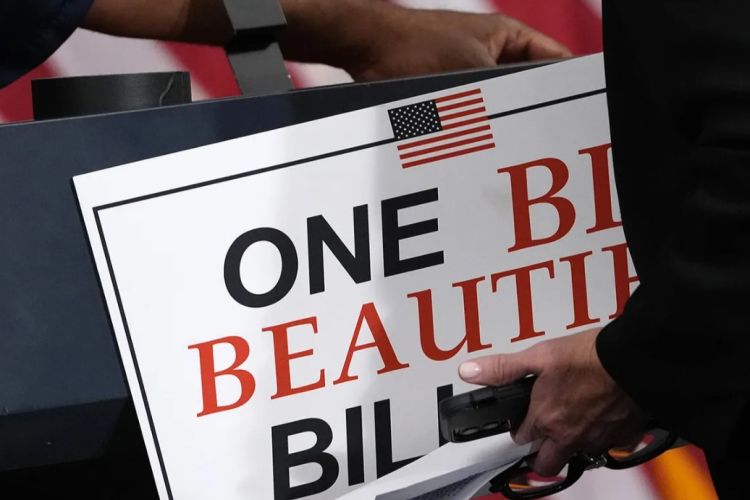
Trump tax cuts may trigger US debt crisis: President Donald Trump’s so-called “One Big Beautiful Bill” has now cleared the House, riding a tide of Republican enthusiasm. It is a sprawling, 1,116-page legislative monument to economic populism: tax cuts for individuals and businesses, spending increases for defence and border enforcement, and aggressive reforms to Medicaid and food assistance programmes. But beneath the grandiose packaging lies a grim fiscal reality—this bill is not beautiful. It can be dangerous.
According to preliminary estimates, the bill will add at least $3.1 trillion to the US debt over the next decade. Interest rates are already rising, US Treasury yields have hit multi-year highs, and Moody’s has stripped the US of its last perfect credit rating. Fiscal hawks call it a “debt bomb,” and they are not wrong.
READ | Solar energy: India’s power grid faces new risks from RE surge
A recipe for fiscal instability
The bill’s most prominent feature is the extension—and expansion—of Trump’s 2017 tax cuts. While supporters claim it will prevent a de facto tax hike when the current cuts expire, what it actually does is deepen America’s structural deficits. The Committee for a Responsible Federal Budget projects that the tax measures alone would cost $3.8 trillion, dwarfing the roughly $1 trillion in cuts to social spending.

This is not a recipe for fiscal responsibility. It is a reverse-Robin Hood policy. Wealthy households stand to gain an average tax cut of $12,660 next year. Middle-income families may receive around $1,840. But lower-income households? They get a paltry $160 on average—while simultaneously facing cuts to Medicaid, food stamps (SNAP), and housing aid.
Let us be clear: this is deficit financing in its most regressive form.
Families will pay—not just in taxes
Though the White House insists this bill “does not add to the deficit,” the bond markets disagree. Yields on 30-year Treasurys touched 5.15% last week, their highest level since October 2023. Why? Because markets know what politicians pretend not to: the US is becoming less creditworthy.
This has direct consequences for American households. Rising Treasury yields increase borrowing costs across the economy—from mortgages to auto loans to credit cards. A 1% rise in interest rates adds roughly $360 billion in annual interest payments to the federal government’s tab, which in turn pressures policymakers to raise taxes or cut spending elsewhere.
Thus, the burden will not merely fall on future generations. It is already trickling down to families who will pay more to borrow and lose out on essential services today.
Medicaid work requirements
The bill slashes nearly $700 billion from Medicaid over a decade. The savings are achieved not by curbing costs, but by throwing up bureaucratic hurdles—stringent work requirements for “able-bodied adults” up to age 64, biannual eligibility checks, and cuts to states that assist undocumented migrants.
The Congressional Budget Office (CBO) estimates that 8.6 million people could lose coverage. Many of these individuals are not unwilling to work but are unable to navigate complex reporting systems or live in states with limited job opportunities. This is not about waste and fraud; it is about exclusion.
Moreover, repealing protections under the Affordable Care Act—such as auto-reenrolment and special enrolment periods—will increase the number of uninsured Americans by 3 million. The result: more emergency room visits, worse health outcomes, and higher long-term costs for the public system.
SNAP cuts and the erosion of food security
The Supplemental Nutrition Assistance Program, or SNAP, also faces a $267 billion cut. The bill proposes shifting 5% of benefit costs to states beginning in 2028, a move that several governors have warned could result in benefit cuts or stricter eligibility.
Work requirements are being expanded to parents with children over the age of seven, and adults up to 64. Ironically, the majority of SNAP recipients who can work already do—but forcing them to document and verify their hours monthly will push many out of the programme simply due to red tape.
Once again, the impact will fall disproportionately on those least able to absorb it. The USDA’s own data reveals that most states already have payment error rates above 6%. Under the bill’s formula, such states would face higher cost-sharing burdens—creating a vicious cycle of administrative failure and human suffering.
Undermining clean energy, jeopardising jobs
If the economic case for this bill is weak, its climate and industrial logic is worse. The repeal of clean energy tax credits will undermine investments across solar, wind, and EV manufacturing. The Rhodium Group and MIT estimate that over 830,000 jobs are at risk—many in Republican strongholds like Tennessee, Georgia, and Nevada.
These are not theoretical projections. They are based on actual projects greenlit under the Inflation Reduction Act. Removing their tax incentives retroactively will strand capital, raise electricity costs, and reduce energy independence. Aurora Energy Research warns that household electricity bills could rise by 10%, or $142 annually, by 2040.
For a nation already grappling with inflation and wage stagnation, that is no small blow.
A reverse transfer of wealth
The House package is a transfer—not of wealth from the rich to the poor, as Trump’s campaign rhetoric often suggested—but from the vulnerable to the well-off. The wealthiest 5% of Americans will receive more than a third of the tax relief, while low-income families lose access to healthcare, food assistance, and affordable electricity.
Yes, the bill includes symbolic populist provisions—a $1,000 Trump savings account for babies, a $500 increase in the child tax credit, and a repeal of the $200 tax on gun silencers. But these are political baubles, not economic tools. They are dwarfed by the scale of the giveaways to high-income earners and corporations.
The dangerous mirage of fiscal magic
The most disingenuous aspect of this bill is the promise of delayed reforms. House Republicans tout future savings from efficiency gains, anti-fraud measures, and tighter eligibility rules. But as Sen. Thomas Massie bluntly noted, the reforms “don’t kick in for five years.”
We have seen this playbook before. Make the cuts politically palatable in the short run, and kick the hard decisions into the future. The future, however, is now catching up.
Moody’s warning is clear: without credible steps to reverse rising deficits and interest costs, another downgrade is coming. If that happens, the US dollar itself—the bedrock of global finance—could come under threat.
US debt crisis
President Trump’s “big beautiful bill” is less a serious fiscal plan than a politically expedient gamble. It promises lower taxes for the rich, throws a few bones to the middle class, and pays for it by slashing benefits for those who can least afford it.
It adds to the debt, fuels inflation, and undermines both energy and job security. If passed, the bill may achieve one thing: it will ensure that future Republican deficits, as Sen. Rand Paul feared, are owned entirely by the GOP.
This is not conservative governance. It is fiscal vandalism masquerading as reform—and American families will pay the price.
